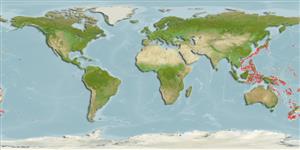Classification / Names
Common names from other countries
Main reference
Size / Weight / Age
Max length : 21.0 cm TL male/unsexed; (Ref. 559)
Environment
Marine; bathydemersal; depth range 500 - 535 m (Ref. 26282)
Climate / Range
Deep-water, preferred ?
Distribution
Short description
Mouth inferior with narrow tooth band on lower jaw, a large area of spineless scales behind 1st dorsal fin, and slender dense spinules on scales. Ventral luminous organ rather large, situated between pelvic bases and connected with black periproct by narrow naked groove; lens faintly visible on photophore. First dorsal largely blackish, white distally and basally. Anterior portion of anal fin with narrow black margin. Vent located before a vertical through origin of 1st dorsal fin (Ref. 54421).
IUCN Red List Status (Ref. 115185)
Threat to humans
Harmless
Human uses
More information
Common namesSynonymsMetabolismPredatorsEcotoxicologyReproductionMaturitySpawningFecundityEggsEgg development
Age/SizeGrowthLength-weightLength-lengthLength-frequenciesMorphometricsMorphologyLarvaeLarval dynamicsRecruitmentAbundance
ReferencesAquacultureAquaculture profileStrainsGeneticsAllele frequenciesHeritabilityDiseasesProcessingMass conversion
Tools
Special reports
Download XML
Internet sources
Estimates of some properties based on models
Phylogenetic diversity index
PD50 = 0.5000 many relatives (e.g. carps) 0.5 - 2.0 few relatives (e.g. lungfishes)
Trophic Level
3.6 ±0.5 se; Based on size and trophs of closest relatives
Resilience
Medium, minimum population doubling time 1.4 - 4.4 years (Preliminary K or Fecundity.)
Vulnerability
Low to moderate vulnerability (30 of 100)
Price category
